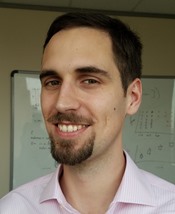Program Information
A Novel Method to Map Endoscopic Video to CT for Treatment Planning and Toxicity Analysis in Radiation Therapy
W Ingram*, J Yang , B Beadle , R Wendt , A Rao , L Court , The University of Texas MD Anderson Cancer Center, Houston, TX
Presentations
TU-AB-202-12 (Tuesday, August 2, 2016) 7:30 AM - 9:30 AM Room: 202
Purpose:Endoscopic examinations are routine procedures for head-and-neck cancer patients. Our goal is to develop a method to map the recorded video to CT, providing valuable information for radiotherapy treatment planning and toxicity analysis.
Methods:We map video frames to CT via virtual endoscopic images rendered at the real endoscope’s CT-space coordinates. We developed two complementary methods to find these coordinates by maximizing real-to-virtual image similarity:
(1)Endoscope Tracking: moves the virtual endoscope frame-by-frame until the desired frame is reached. Utilizes prior knowledge of endoscope coordinates, but sensitive to local optima.
(2)Location Search: moves the virtual endoscope along possible paths through the volume to find the desired frame. More robust, but more computationally expensive.
We tested these methods on clay phantoms with embedded markers for point mapping and protruding bolus material for contour mapping, and we assessed them qualitatively on three patient exams. For mapped points we calculated 3D-distance errors, and for mapped contours we calculated mean absolute distances (MAD) from CT contours.
Results:In phantoms, Endoscope Tracking had average point error=0.66±0.50cm and average bolus MAD=0.74±0.37cm for the first 80% of each video. After that the virtual endoscope got lost, increasing these values to 4.73±1.69cm and 4.06±0.30cm. Location Search had point error=0.49±0.44cm and MAD=0.53±0.28cm. Point errors were larger where the endoscope viewed the surface at shallow angles<10 degrees (1.38±0.62cm and 1.22±0.69cm for Endoscope Tracking and Location Search, respectively). In patients, Endoscope Tracking did not make it past the nasal cavity. However, Location Search found coordinates near the correct location for 70% of test frames. Its performance was best near the epiglottis and in the nasal cavity.
Conclusion:Location Search is a robust and accurate technique to map endoscopic video to CT. Endoscope Tracking is sensitive to erratic camera motion and local optima, but could be used in conjunction with anchor points found using Location Search.
Contact Email:

